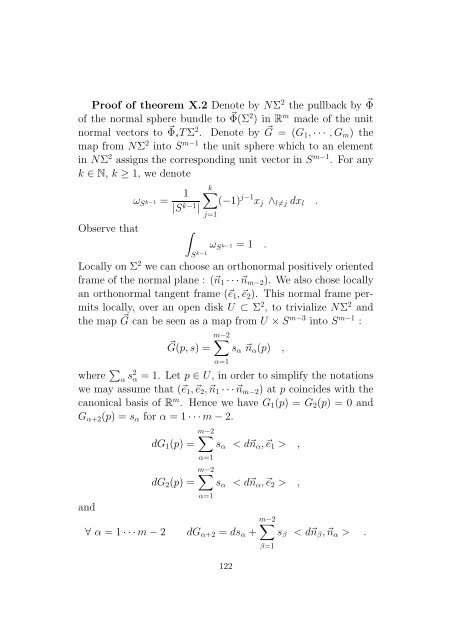Conformally Invariant Variational Problems. - SAM
Conformally Invariant Variational Problems. - SAM
Conformally Invariant Variational Problems. - SAM
Create successful ePaper yourself
Turn your PDF publications into a flip-book with our unique Google optimized e-Paper software.
Proof of theorem X.2 Denote by NΣ 2 the pullback by Φ ⃗<br />
of the normal sphere bundle to Φ(Σ ⃗ 2 ) in R m made of the unit<br />
normal vectors to Φ ⃗ ∗ TΣ 2 . Denote by G ⃗ = (G 1 ,··· ,G m ) the<br />
map from NΣ 2 into S m−1 the unit sphere which to an element<br />
in NΣ 2 assigns the corresponding unit vector in S m−1 . For any<br />
k ∈ N, k ≥ 1, we denote<br />
Observe that<br />
ω S<br />
k−1 = 1<br />
|S k−1 |<br />
∫<br />
k∑<br />
(−1) j−1 x j ∧ l≠j dx l .<br />
j=1<br />
S k−1 ω S<br />
k−1 = 1 .<br />
Locally on Σ 2 we can choose an orthonormal positively oriented<br />
frame of the normal plane : (⃗n 1···⃗n m−2 ). We also chose locally<br />
an orthonormal tangent frame (⃗e 1 ,⃗e 2 ). This normal frame permits<br />
locally, over an open disk U ⊂ Σ 2 , to trivialize NΣ 2 and<br />
the map ⃗ G can be seen as a map from U ×S m−3 into S m−1 :<br />
⃗G(p,s) =<br />
m−2<br />
∑<br />
α=1<br />
s α ⃗n α (p) ,<br />
where ∑ α s2 α = 1. Let p ∈ U, in order to simplify the notations<br />
we may assume that (⃗e 1 ,⃗e 2 ,⃗n 1···⃗n m−2 ) at p coincides with the<br />
canonical basis of R m . Hence we have G 1 (p) = G 2 (p) = 0 and<br />
G α+2 (p) = s α for α = 1···m−2.<br />
and<br />
dG 1 (p) =<br />
dG 2 (p) =<br />
m−2<br />
∑<br />
α=1<br />
m−2<br />
∑<br />
α=1<br />
∀ α = 1···m−2 dG α+2 = ds α +<br />
s α < d⃗n α ,⃗e 1 > ,<br />
s α < d⃗n α ,⃗e 2 > ,<br />
122<br />
m−2<br />
∑<br />
β=1<br />
s β < d⃗n β ,⃗n α > .
















